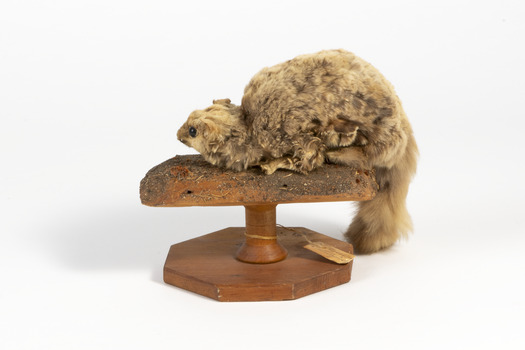Historical information
Krefft's glider (Petaurus notatus) is a small, nocturnal, arboreal marsupial known for its ability to glide. It is native to much of eastern mainland Australia and has also been introduced to Tasmania. The classification of Petaurus populations from New Guinea and Indonesia, previously assigned to P. breviceps, remains under review. The American Society of Mammalogists tentatively includes these populations within P. notatus, though they may represent a complex of distinct species. Notably, most captive gliders referred to as "sugar gliders" in the United States are believed to originate from West Papua, suggesting they may actually be Krefft's gliders, though this classification is still under study.
This specimen is part of a collection of almost 200 animal specimens that were originally acquired as skins from various institutions across Australia, including the Australian Museum and the National Museum of Victoria, as well as individuals such amateur anthropologist Reynell Eveleigh Johns between 1860-1880. These skins were then mounted by members of the Burke Museum Committee and put-on display in the formal space of the Museum’s original exhibition hall where they continue to be on display. This display of taxidermy mounts initially served to instruct visitors to the Burke Museum of the natural world around them, today it serves as an insight into the collecting habits of the 19th century.
Significance
The specimen is part of a significant and rare taxidermy mount collection in the Burke Museum. This collection is scientifically and culturally important for reminding us of how science continues to shape our understanding of the modern world. They demonstrate a capacity to hold evidence of how Australia's fauna history existed in the past and are potentially important for future environmental, climate and conservation research.
Physical description
Small sized glider with a pointed head, curved body, bushy tail, and curved claws perched on a wooden mount. The pelage is thick, long and silky in pale caramel and tan shades. The head is small with two pointed ears, two glass eyes, and about five teeth.
Inscriptions & markings
On wooden mount:
BMM5895 /
Subjects
References
- Fauna of Australia by John E. Nelson Scientific government publication about the Flying Foxes in Australia.
- Menkhorst, P., Rogers, D., Clarke, R., Davies, J., Marsack, P. & Franklin, K. 2019, The Australian Bird Guide, CSIRO Publishing, Clayton, Victoria.




















